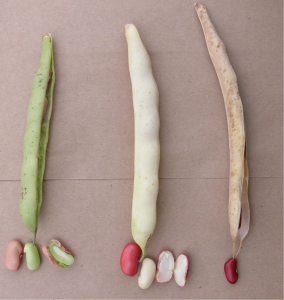Authors: Meghan Moran and Mike Cowbrough
Harvest aid treatments in dry edible beans will provide a more even dry down of the crop and any escaped weeds, making harvest more efficient. Controlling escaped weeds can also reduce seed stain, improving bean quality. There are six products registered for pre-harvest use in edible beans in Ontario, and the label rates and application timing are provided in Table 1. Aim, Ignite, Reglone and Valtera are contact herbicides that require higher water volumes and good coverage, and will provide rapid dry down of plant material. Eragon is translocated within plants, and provides control of weeds as well as dry down of bean plants. Glyphosate is slower acting, and is primarily used to control weeds or prevent crop regrowth.
Reglone causes rapid necrosis and is best applied at dusk or on a cloudy day to increase plant uptake before cell membranes are disrupted and necrosis occurs. Aim, Valtera and Eragon should be applied on warm, sunny days to activate accumulation of damaging molecules.
Table 1. Pesticide label rates and guidelines around harvest aid treatments for dry edible beans
| Harvest Aid | Rate | Timing |
| Aim EC + Non-ionic surfactant | 47 mL/ac +0.25% v/v | Apply to dry bean when 80-90% of bean leaves have fallen and pods are mature. |
| Eragon LQ + Merge | 29.5 – 59 mL/ac
+ 0.5% v/v |
Apply when 90% of pods have changed from green to yellow to brown. Harvest can commence within 3 -10 days after application. |
| Glyphosate (360 g/L) | 1 L/ac | Apply when stems are green to brown in colour; pods are mature (yellow to brown in colour); 80-90% leaf drop (original leaves). |
| Ignite 150 SN | 1 – 1.2 L/ha | Apply when 50 -75% of the bean pods have changed colour from green to yellow or brown. Allow 9 days before harvesting. |
| Reglone + Non-ionic surfactant | 0.5 – 0.92 L/ac + 0.1% v/v | Apply when at least 80% of the pods have turned yellow. Harvest can commence within 4 -10 days after application. |
| Valtera + MSO Concentrate | 42 g/ac + 1 L/ac | Product label does not specify a specific timing other than a statement of “Do not harvest within 5 days of application”. |
Timing of harvest aids is critical to maximize the quality and yield of dry bean seed. Pre-harvest herbicides will not speed the maturity of the plants or decrease seed moisture, but can shorten the time between crop maturity and harvest. Pod colour change is the best indication of maturity; leaf drop and leaf colour are not good indicators. Once a herbicide is applied, late pods will not continue to mature so ensure the beans have the desired colour before application and are not green when split open. Herbicide labels provide guidance around timing, but it can be tricky to visualize exactly what “80% of pods have turned” actually looks like. Different edible bean classes have different pod colour when beans are fully mature. Figures 1 through 12 at the end of the article are visual examples of different market classes of dry edible beans when they are ready for an application of a harvest aid treatment, compared to when it’s too early.
Considerations When Using Glyphosate
Bean dealers may have restrictions in place on what products can be used pre-harvest for certain bean classes or markets, and in this particular year growers should ensure they confirm with their dealer. Concerns around the use of glyphosate are at the forefront again. Authorization of glyphosate in the European Union was set to expire in June and re-authorization came in the form of an 18 month extension in the final days of discussions. For this reason some bean dealers may have restrictions on the use of glyphosate pre-harvest.
The label for glyphosate indicates that it should not be applied until beans reach 30% moisture or less because the seed can take up glyphosate residues. There is also a 7 day pre-harvest interval. Care should be taken in unevenly maturing fields to ensure application is occurring when all plants are at 30% moisture or below. Field research by Drs. K. McNaughton, C. Gillard and colleagues in Western Canada over a 4 year period shows that unacceptable levels of glyphosate are taken up by the seed if it is applied before plants reach 75% maturity. Also, application of glyphosate with Eragon at 75% maturity reduced bean yields by 16% compared to application at full maturity. Hundred seed weight, pick and quality (colour) were improved when pre-harvest glyphosate or glyphosate plus Eragon was applied around 100% maturity. Careful determination of the crop maturity is important for residue levels as well as profit.
How effective are different pre-harvest treatments at “drying down” common weeds?
There is limited public research comparing performance of pre-harvest treatments on different weed species. Dr. Peter Sikkema has conducted six trials over three seasons on edible beans and his results are summarized below. Regardless of treatment used, the expectation should be that the pre-harvest treatment will improve harvest efficiency but it will not result in a complete “dry down” of target weeds.
Table 2. Visual Control of lamb’s-quarters, ragweed, pigweed and foxtail 8 days after application of various desiccant treatments
| Pre Harvest Treatment | Visual Control (%) 8 days after application | |||
| lambsquarter | ragweed | pigweed | foxtail | |
| Aim EC (47 mL/ac) + NIS1 (0.25% v.v) | 30 | 12 | 29 | 7 |
| Eragon LQ (59 mL/ac) + Merge (0.5% v.v) | 46 | 73 | 64 | 26 |
| glyphosate (1L/ac)* | 29 | 17 | 38 | 63 |
| Ignite (1.2 L/ac) | 70 | 66 | 65 | 52 |
| Reglone (0.92 L/ac) + NIS1 (0.1% v/v) | 73 | 80 | 78 | 47 |
| Valtera (42 g/ac) + MSO Concentrate (1 L/ac) | 38 | 52 | 41 | 32 |
* glyphosate rate per acre is based on a product concentration of 360 g/L (e.g. Roundup Original)1 NIS = Non ionic surfactant (numerous products/trade names are available)Source: Dr. P. Sikkema, 6 Trials: DB10D1A, DB10D1B, DB11D1A, DB11D1B, DB12D1A, DB12D1B. Weed Control Trials Research Report, 2010, 2011 and 2012. University of Guelph, Ridgetown Campus. |
||||
White beans: Pods change from green to yellow, almost brown.
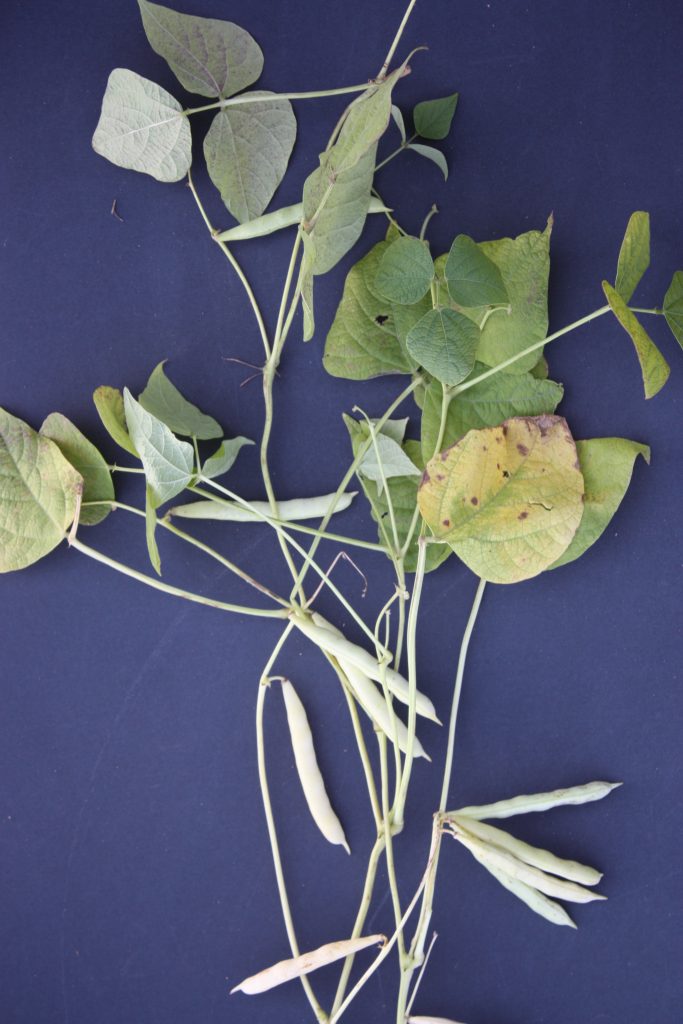
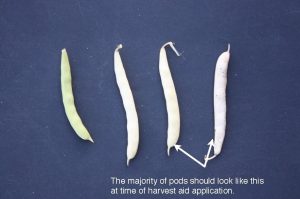
Black beans: Pods change from green to a red colour when mature.
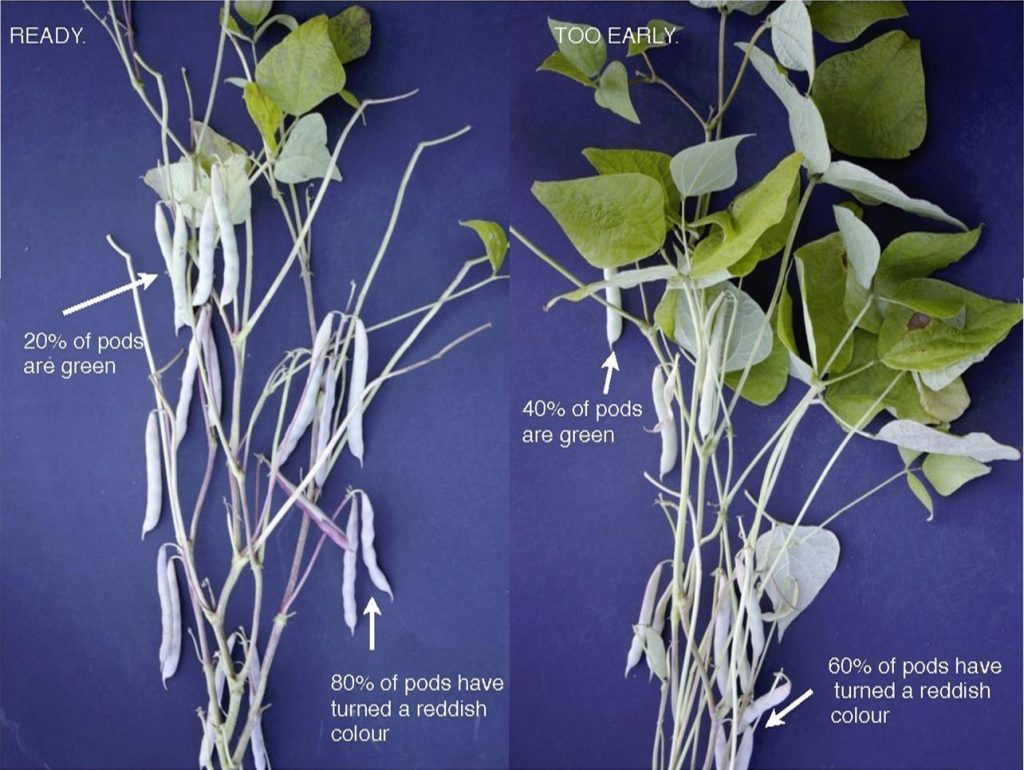
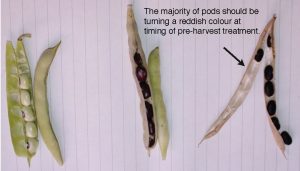
Adzuki beans: Pods turn from green to yellow to brown.
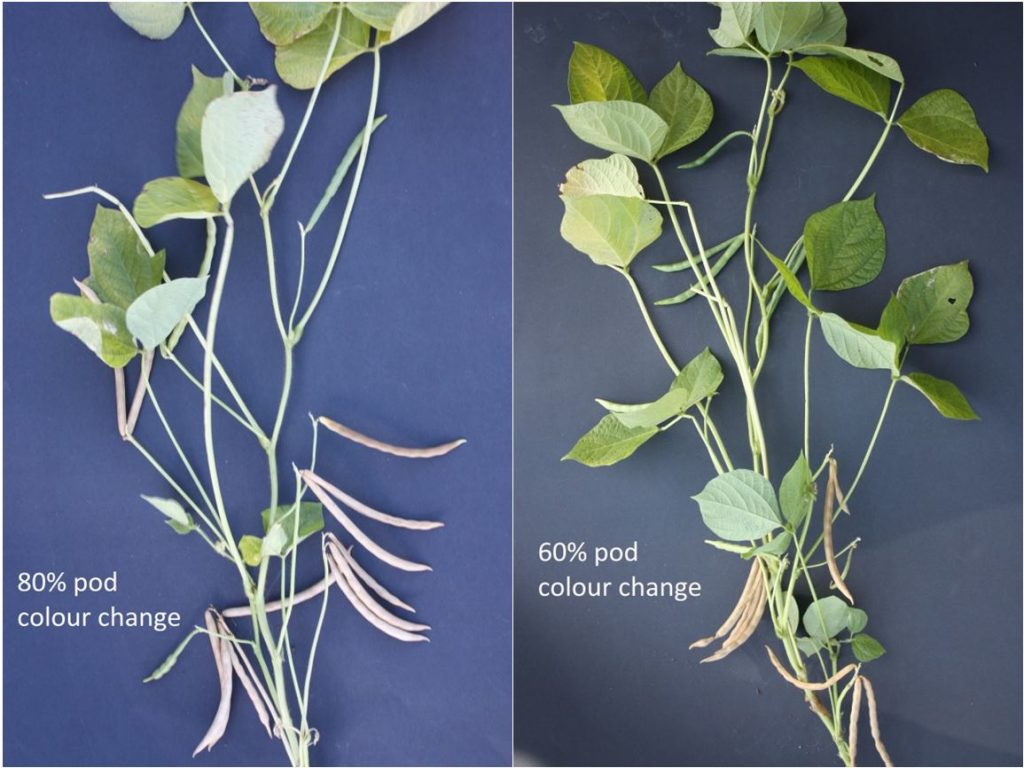

Otebo beans: Pods change from green to brown or reddish brown.
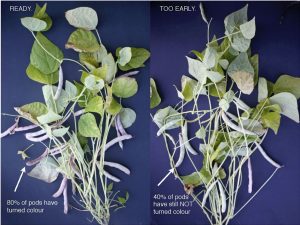
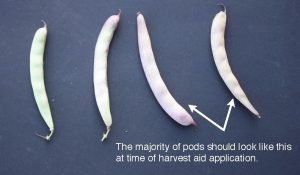
Cranberry beans: Pods change from green to white-ish with red or pink speckles. The red or pink speckling on pods increases with maturity.

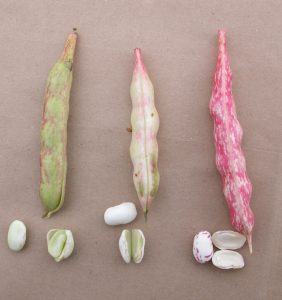
Dark Red Kidney beans: Pods turn from green to yellow or white, to light brown when fully mature.

